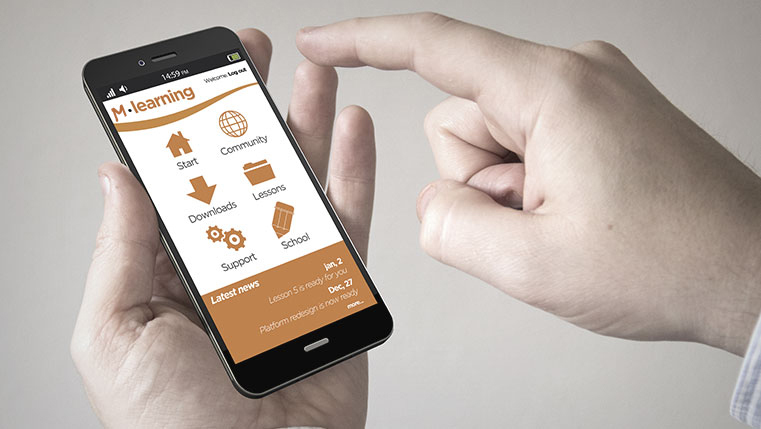6 Top Considerations For Designing Mobile Learning

There is no doubt that mobile learning has caught the imagination of e-learning developers worldwide. Organizations are receptive to the idea of providing anytime, anywhere learning to their employees. But wait, mobile learning does not mean dumping e-learning content into a mobile device.
→ Download Now: Mobile Learning: How to Overcome Implementation Barriers
E-learning developers will have to remember that designing for mobile learning requires a different approach, and is not the same as developing a regular e-learning course.
Apart from the content, considerations such as designing for the smaller mobile or tablet screen must be taken into account. The design has to be tailored to suit the advantages of learning on a mobile device and also consider its limitations.
This blog will highlight some of the considerations when designing mobile learning or m-learning.
Consider the Device you are Designing for
When designing for mobile devices, you need to keep in mind the specific device you are designing for – iPhone, Android device, or iPad. You should be aware of the limitations of Flash, which is not compatible across all devices. This will help you know your design limitations and will help you when you have to consider learner interaction in your design. Design with the smallest device in mind, because when you are designing for multiple devices, the learning experience has to be well-designed for each device.
User Experience
When you are designing for mobiles and tablets, be aware that the learning environment you create is sensitive to the user interface differences that are integral to a touch screen device.
The course size should be small; keep in mind that people will be accessing these courses anytime and anywhere, so ideally they have to be focused, compact, and capture the attention of the learner. Ideally, an m-learning module should not be more than 10-15 minutes in duration.
The size and type of content should be carefully selected because too much content can result in poor user experience. For instance, smartphones will not serve the purpose when you need to include practice for mastery courses because they lack the resolution and screen size required for such courses. It will be difficult to include ‘what if’ scenarios or compare and contrast interactivities that such courses require. Similarly, if the learning objectives are retention and skill application, then tablets would be a better choice.
Other tips you should consider for a better user experience are:
- Lock the lesson window to avoid panning and zooming, this will allow for drag and drop interactions.
- Avoid scrolling; this will be difficult to handle on a smaller screen.
- Understand and visualize how users will hold the intended device.
- Ensure objects and buttons are easy to access. Objects should be large and enough buffer area should be provided around them.
- When including quizzes, keep them short and brief and limit the choices to two or three options.
- Functionality should be kept to the minimum to result in a simple interface that users can easily understand.
Imagery and Fonts
- Imagery should be bold and should be on a white background.
- Icons and graphics should be used to represent content instead of text.
- Avoid using irrelevant or large images.
- Use clear and simple images.
- Use strong visual cues such as bright colors or descriptive icons.
- The default font size should be 14 points, the minimum font size should be 12 points.
- Avoid using text in images; this can result in compressed or fuzzy images.
- Use minimum custom fonts as more can increase the page load time.
File Size
Another aspect to consider for m-learning would be the file size of the course. When there is limited access to Wi-Fi, learners will be reluctant to use their connection to access content. So your design should consider the overall size of your content and what is included in it.
If learners have to access the course on their smartphones in locations where there is no access to Wi-Fi, they may be reluctant to watch large videos or download heavy media content. Remember, the storage capacity of some devices may not be suited for large file sizes. The content should be available both online and offline to suit intermittent Internet connectivity.
Design for Low Error Rates
There are higher chances of selection errors on mobile phones because one has to use fingers, which can be clumsy or there can be distractions during use. This can lead to a higher rate of tap errors and going back and forth in the course. So try and minimize tap errors by using as much whitespace as possible in selection areas. Ensure that when a user taps something on the screen, it invokes the correct action.
Visual Clarity
The visual design of the course has to ensure that users do not misunderstand the cues on the screen. The screen should be organized as far as possible to ensure clarity for users. For this, the features should be segregated as essential and extraneous so that the right ones are used to maintain visual clarity.
For better design of m-learning, keep the end-user in mind. This will help you create an engaging, useful, and pleasant mobile learning experience that learners can truly benefit from.





![5 Reasons Mobile Learning is the Need of the Hour [SlideShare]](https://blog.commlabindia.com/hubfs/Imported_Blog_Media/mobile-learning-use-corporate-training-reasons-slideshare.jpg)